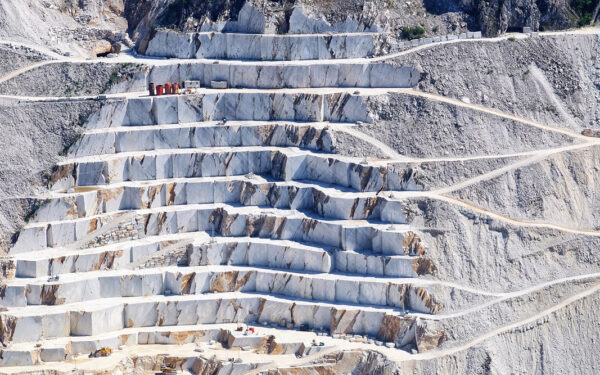Marble has long been celebrated for its timeless beauty and unparalleled elegance, making it a favoured choice for benchtops in kitchens and bathrooms. Its luxurious appeal and unique veining and patterns add a touch of sophistication to any space. This article explores marble’s qualities, suitability for benchtops, and the modern production process that brings this stunning stone from the quarry to your home.
The Qualities of Marble
1. Aesthetic Appeal: Marble is renowned for its stunning visual appeal. Each slab is unique, featuring various colours and veining patterns resulting from mineral impurities like clay, silt, sand, or iron oxides. This natural variability ensures that no two marble benchtops are identical, offering a bespoke look that adds character and elegance to any interior design.
2. Durability: Marble is a durable material that, when properly maintained, can last for decades. Its ability to withstand heat makes it particularly suitable for kitchen benchtops. However, marble is softer than granite, which makes it more prone to scratches and etching, particularly from acidic substances like lemon juice or vinegar.
3. Heat Resistance: One of marble’s standout qualities is its heat resistance. This property makes it an excellent choice for kitchen benchtops where hot pots and pans are frequently used. However, it’s still advisable to use trivets or heat pads to protect the surface from thermal shock.
4. Cool Surface: Marble remains cool to the touch, an advantage for bakers and chefs. The cool surface is ideal for rolling out dough and working with pastry, making marble benchtops a practical choice for avid home cooks.
5. Versatility: Marble comes in a wide range of colours, from pristine whites and deep blacks to various shades of green, pink, and grey. This versatility complements various design styles, from classic and traditional to modern and contemporary.
Suitability for Benchtops
1. Kitchens: Marble benchtops are popular in kitchens for their aesthetic appeal and heat resistance. However, they require regular sealing to protect against staining and etching. It’s also essential to clean up spills immediately to prevent damage.
2. Bathrooms: Marble is often used for vanity tops, shower walls, and bathroom flooring. Its luxurious look elevates the space, creating a spa-like atmosphere. Like in the kitchen, proper maintenance is key to preserving its beauty.
3. Maintenance: Maintaining marble benchtops involves regular sealing to prevent stains and using pH-neutral cleaners to avoid etching. It is also advisable to use cutting boards and avoid placing acidic substances directly on the surface.
The Modern Process of Production
 1. Quarrying: Marble’s journey begins in quarries, where large stone blocks are extracted from the earth. This process involves drilling, cutting, and sometimes blasting to remove the stone. Modern technology, such as diamond wire saws, has made the extraction process more efficient and less wasteful.
1. Quarrying: Marble’s journey begins in quarries, where large stone blocks are extracted from the earth. This process involves drilling, cutting, and sometimes blasting to remove the stone. Modern technology, such as diamond wire saws, has made the extraction process more efficient and less wasteful.
2. Block Dressing: Once the marble blocks are extracted, they are transported to processing plants. Here, the blocks are dressed and trimmed into manageable sizes and any irregularities or defects.
3. Slab Production: The dressed blocks are cut into slabs using gang or wire saws. These machines use a series of blades or wires to slice the blocks into thin slabs, the thickness of which can vary depending on the intended use.
4. Surface Finishing: After cutting, the slabs undergo surface finishing to enhance their appearance and functionality. This process can include polishing, honing, or brushing. Polishing gives the marble a glossy, reflective surface, while honing produces a matte finish. Brushing creates a textured surface that adds depth and character.
5. Quality Control: Quality control is a crucial step in the production process. Each slab is inspected for defects, such as cracks, chips, or colour inconsistencies. Slabs that meet the quality standards are then graded and sorted based on colour, pattern, and overall appearance.
6. Cutting and Fabrication: Once the slabs are ready, they are cut and fabricated into specific shapes and sizes for benchtops. This involves precise measurements and cutting to ensure a perfect fit. Edge profiling is also done at this stage, where the edges of the benchtops are shaped and finished according to the desired style.
7. Sealing and Finishing: Before the marble benchtops are installed, they are sealed to protect against stains and moisture. This sealing process involves applying a protective layer to the surface, penetrating the stone and creating a barrier against spills and dirt.
8. Installation: The final step is installation. Professional installers ensure that the benchtops are securely placed and levelled. They also make any necessary adjustments to fit around sinks, stovetops, and other fixtures. Proper installation is crucial to ensure the longevity and stability of the benchtops.
Conclusion
Marble benchtops bring timeless elegance and luxury to any space. Their unique beauty, heat resistance, and cool surface make them an excellent choice for kitchens and bathrooms. However, they require proper maintenance and care to preserve their appearance and functionality. The modern marble production process, from quarrying to installation, ensures that each benchtop is crafted to the highest quality and durability standards. By understanding the qualities of marble and the steps involved in its production, homeowners can make informed decisions and enjoy the enduring beauty of marble benchtops in their homes.

